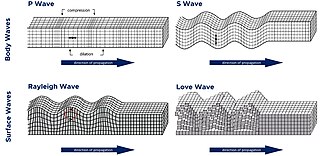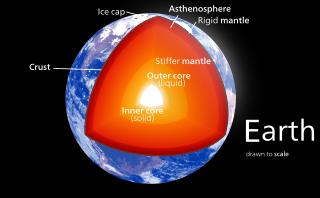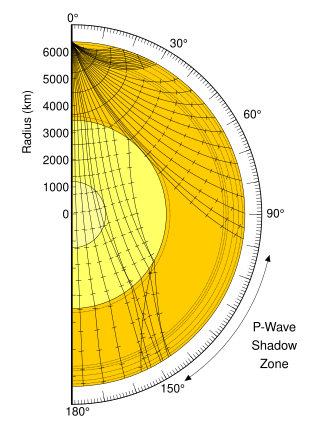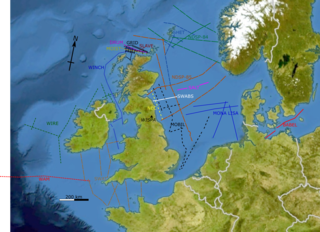Related Research Articles

A seismic wave is a mechanical wave of acoustic energy that travels through the Earth or another planetary body. It can result from an earthquake, volcanic eruption, magma movement, a large landslide, and a large man-made explosion that produces low-frequency acoustic energy. Seismic waves are studied by seismologists, who record the waves using seismometers, hydrophones, or accelerometers. Seismic waves are distinguished from seismic noise, which is persistent low-amplitude vibration arising from a variety of natural and anthropogenic sources.

The Mohorovičić discontinuity – usually called the Moho discontinuity, Moho boundary, or just Moho – is the boundary between the crust and the mantle of Earth. It is defined by the distinct change in velocity of seismic waves as they pass through changing densities of rock.
Seismic tomography is a technique for imaging the subsurface of the Earth with seismic waves produced by earthquakes or explosions. P-, S-, and surface waves can be used for tomographic models of different resolutions based on seismic wavelength, wave source distance, and the seismograph array coverage. The data received at seismometers are used to solve an inverse problem, wherein the locations of reflection and refraction of the wave paths are determined. This solution can be used to create 3D images of velocity anomalies which may be interpreted as structural, thermal, or compositional variations. Geoscientists use these images to better understand core, mantle, and plate tectonic processes.

Reflection seismology is a method of exploration geophysics that uses the principles of seismology to estimate the properties of the Earth's subsurface from reflected seismic waves. The method requires a controlled seismic source of energy, such as dynamite or Tovex blast, a specialized air gun or a seismic vibrator. Reflection seismology is similar to sonar and echolocation.

A P wave is one of the two main types of elastic body waves, called seismic waves in seismology. P waves travel faster than other seismic waves and hence are the first signal from an earthquake to arrive at any affected location or at a seismograph. P waves may be transmitted through gases, liquids, or solids.

The internal structure of Earth is the solid portion of the Earth, excluding its atmosphere and hydrosphere. The structure consists of an outer silicate solid crust, a highly viscous asthenosphere and solid mantle, a liquid outer core whose flow generates the Earth's magnetic field, and a solid inner core.

The Iceland hotspot is a hotspot which is partly responsible for the high volcanic activity which has formed the Iceland Plateau and the island of Iceland.

The EarthScope project was an National Science Foundation (NSF) funded earth science program that, from 2003-2018, used geological and geophysical techniques to explore the structure and evolution of the North American continent and to understand the processes controlling earthquakes and volcanoes. The project had three components: USArray, the Plate Boundary Observatory, and the San Andreas Fault Observatory at Depth. Organizations associated with the project included UNAVCO, the Incorporated Research Institutions for Seismology (IRIS), Stanford University, the United States Geological Survey (USGS) and National Aeronautics and Space Administration (NASA). Several international organizations also contributed to the initiative. EarthScope data are publicly accessible.
Seismic anisotropy is the directional dependence of the velocity of seismic waves in a medium (rock) within the Earth.

A seismic shadow zone is an area of the Earth's surface where seismographs cannot detect direct P waves and/or S waves from an earthquake. This is due to liquid layers or structures within the Earth's surface. The most recognized shadow zone is due to the core-mantle boundary where P waves are refracted and S waves are stopped at the liquid outer core; however, any liquid boundary or body can create a shadow zone. For example, magma reservoirs with a high enough percent melt can create seismic shadow zones.
Seismic migration is the process by which seismic events are geometrically re-located in either space or time to the location the event occurred in the subsurface rather than the location that it was recorded at the surface, thereby creating a more accurate image of the subsurface. This process is necessary to overcome the limitations of geophysical methods imposed by areas of complex geology, such as: faults, salt bodies, folding, etc.
The receiver function technique is a way to image the structure of the Earth and its internal boundaries by using the information from teleseismic earthquakes recorded at a three-component seismograph.
The continent-ocean boundary (COB) or continent-ocean transition is the boundary between continental crust and oceanic crust on a passive margin. The identification of continent-ocean boundaries is important in the definition of plate boundaries at the time of break-up when trying to reconstruct the geometry and position of ancient continents e.g. in the reconstruction of Pangaea.

The Nankai Trough is a submarine trough located south of the Nankaidō region of Japan's island of Honshu, extending approximately 900 km (559 mi) offshore. The underlying fault, the Nankai megathrust, is the source of the devastating Nankai megathrust earthquakes, while the trough itself is potentially a major source of hydrocarbon fuel, in the form of methane clathrate.

The Jan Mayen Microcontinent is a fragment of continental crust within the oceanic part of the western Eurasian Plate lying northeast of Iceland. At the onset of separation between the Greenland and Eurasian plates 55 million years ago, it formed part of the eastern margin of the Greenland Plate. Propagation of a new spreading center from the Reykjanes Ridge separated this microcontinent from the Greenland Plate. For a short period it formed a microplate, until the Aegir Ridge became inactive, after which it formed part of the Eurasian Plate. The island of Jan Mayen is a much younger feature, formed of volcanic rock, built up at the northernmost tip of the microcontinent.
A synthetic seismogram is the result of forward modelling the seismic response of an input earth model, which is defined in terms of 1D, 2D or 3D variations in physical properties. In hydrocarbon exploration this is used to provide a 'tie' between changes in rock properties in a borehole and seismic reflection data at the same location. It can also be used either to test possible interpretation models for 2D and 3D seismic data or to model the response of the predicted geology as an aid to planning a seismic reflection survey. In the processing of wide-angle reflection and refraction (WARR) data, synthetic seismograms are used to further constrain the results of seismic tomography. In earthquake seismology, synthetic seismograms are used either to match the predicted effects of a particular earthquake source fault model with observed seismometer records or to help constrain the Earth's velocity structure. Synthetic seismograms are generated using specialized geophysical software.
Shear wave splitting, also called seismic birefringence, is the phenomenon that occurs when a polarized shear wave enters an anisotropic medium. The incident shear wave splits into two polarized shear waves. Shear wave splitting is typically used as a tool for testing the anisotropy of an area of interest. These measurements reflect the degree of anisotropy and lead to a better understanding of the area's crack density and orientation or crystal alignment. We can think of the anisotropy of a particular area as a black box and the shear wave splitting measurements as a way of looking at what is in the box.
An ocean-bottom seismometer (OBS) is a seismometer that is designed to record the earth motion under oceans and lakes from man-made sources and natural sources.
The upper mantle of Earth is a very thick layer of rock inside the planet, which begins just beneath the crust and ends at the top of the lower mantle at 670 km (420 mi). Temperatures range from approximately 500 K at the upper boundary with the crust to approximately 1,200 K at the boundary with the lower mantle. Upper mantle material that has come up onto the surface comprises about 55% olivine, 35% pyroxene, and 5 to 10% of calcium oxide and aluminum oxide minerals such as plagioclase, spinel, or garnet, depending upon depth.

The British Institutions Reflection Profiling Syndicate, better known by its acronym BIRPS, was set up to acquire deep seismic reflection profiles around the United Kingdom Continental Shelf (UKCS). It was formed, initially as BURPS, the British Universities Reflection Profiling Syndicate, involving geophysicists from the Natural Environment Research Council (NERC) and British Universities. After the involvement of other institutions the name was changed to BIRPS and by February 1981 NERC had approved funding for a four-year programme. The next ten years saw the collection of 12,000 km of deep seismic profiles around the British Isles. By the time NERC stopped funding the program in 1997, more than 20,000 km of data had been acquired.
References
- 1 2 Hübscher, C.; Gohl, K. (2014). "Reflection/Refraction Seismology" (PDF). In Harff, J; Meschede, M.; Petersen, S.; Thiede, J. (eds.). Encyclopedia of Marine Geosciences. Springer Science+Business Media Dordrecht. pp. 1–15. doi:10.1007/978-94-007-6644-0_128-1. ISBN 978-94-007-6644-0.
- 1 2 3 4 White, R.S. (2020). "Chapter 21 - Wide-angle refraction and reflection". In Scarselli, N.; Adam, J.; Chiarella, D.; Roberts, D.G.; Bally, A.W. (eds.). Regional Geology and Tectonics (Second Edition). Principles of Geologic Analysis. Vol. 1 (2 ed.). Elsevier. pp. 557–570. doi:10.1016/B978-0-444-64134-2.00019-5. ISBN 9780444641359.